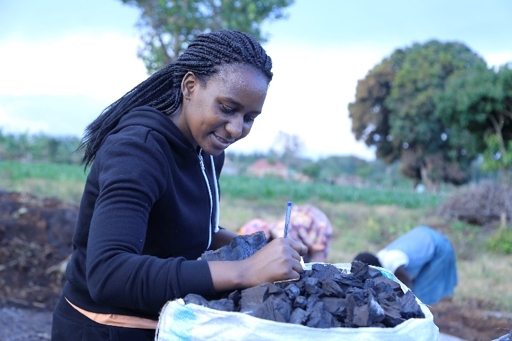
Cooking with biomass and deterioration of air quality. Near Kikumbi, in Mityana district.
In Africa, charcoal is ubiquitous as an energy source for cooking, even in urban areas where electricity and gas are available. Yet when Catherine Nabukalu was taking courses on energy as part of her master’s degree in environmental studies at Penn, she noticed charcoal was often left out of the conversation about energy sources and their contribution to global carbon emissions.
“We would systematically go through coal, then nuclear, then hydropower, then geothermal, solar, etc.,” says Nabukalu, now a project coordinator at the District of Columbia Sustainable Energy Utility. “You become aware that something is missing. Just because you don’t have electricity, doesn’t mean you don’t have energy.”
Reto Gieré, a professor in the Department of Earth and Environmental Science, encouraged her to research charcoal as an energy source for her final paper in his course, Energy, Waste, and the Environment. He then helped her get funding to travel to her native Uganda to continue to pursue the topic as an independent project that they conceptualized together. Nabukalu and Gieré shared the findings in a paper published in the journal Resources.

As a step toward better understanding the full life cycle of charcoal, from creation to consumption, Nabukalu spent time at a number of sites in Uganda where charcoal is created, traded, sold, and consumed. She observed and interviewed participants at each of these stages and reviewed the literature about charcoal production and use worldwide. Gieré and Nabukalu shared some of the key results from this research with Penn Today that shed light on an overlooked source of energy.
Producing charcoal supports a nomadic lifestyle
In the locations Nabukalu visited, people produced charcoal by felling trees, stacking their trunks, and covering them with branches and leaves. A final layer of damp soil serves to keep as much oxygen as possible out when the pile is set alight. In this way, the wood undergoes pyrolysis instead of combustion, leaving behind carbon-dense charcoal.
These kiln installations are created and used only once. “In some cases, this necessitates that the people who use them are nomads,” Gieré notes.
Indeed, some workers interviewed had moved to northern Uganda from the central region specifically for the opportunity to produce charcoal. “Some were entrepreneurs who moved on their own because they thought the trees were disappearing in the more southern areas,” says Nabukalu. “But others were contracted by entrepreneurs that had informal companies to do this work.”
Charcoal production takes a serious environmental toll and is difficult to regulate
Despite efforts by the Ugandan government to regulate charcoal production, it takes place by and large on private lands and thus is nearly impossible to suppress. “Partially, it’s because the government has limited power on private land, but also there is strong demand for the product,” Nabukalu says. Neighboring Tanzania attempted a ban that lasted only a couple of weeks, she found, as prices for charcoal soared on a quickly established black market.
For landowners, allowing charcoal production on their property can be a win-win. They may wish to clear land for agriculture and can invite charcoal producers onto their land, receiving a portion of the proceeds of the product’s eventual sale. For the producers, it gives them a source of income without needing to own land.
While this type of small-scale charcoal production doesn’t involve clearcutting, it still leads to forest degradation as the felled trees are unlikely to be replaced. Each year, Africa produces 24.5 million metric tons of charcoal, nearly 60% of the world’s supply. In addition, much of the supply chain is informal, without any oversight. With traders selling charcoal far from where it is sourced, it is hard to track or quantify how much is actually being produced.
“I think a lot of reports grossly underestimate how much charcoal is being produced and used,” Nabukalu says.

Access to alternative energy sources does not eliminate the use of charcoal
Nabukalu knew from personal experience that access to electricity did not obviate charcoal use. “It’s a matter of home economics,” she says. “When cooking, either you’re going to use charcoal which you’ve already paid for, or you’re going to turn on the gas or the electricity, but you don’t know how high the bill will be.”
In her research she found that Egypt, a country with a diversified mix of modern sources of energy, was still a top producer and importer of charcoal.
That’s true not only in Africa but around the world.
“Take a look at Europe: Having wide and reliable access to electricity hasn’t stopped usage there,” she says, noting that Germany is the world’s top charcoal importer. “You could ask,” Gieré says, “do people in Germany really need to be using it? There it’s for a Sunday barbecue as a leisure fuel, whereas in Uganda it’s used for daily cooking.”
Cooking with charcoal can be dangerous
Nabukalu and Gieré note the health impacts of cooking with charcoal, especially when done without proper ventilation.
“Burning biomass of any kind, whether it be firewood or charcoal, in a confined space exposes those nearby to fumes containing gases and particulates,” says Gieré. “Similarly, producing the charcoal generates vapors during the pyrolysis process, including carbon monoxide, carbon dioxide, and methane, which all deteriorate air quality in the area surrounding the kilns.”
In follow-up work, Hope Elliott, a student in Penn’s Master of Science in Applied Geology program, also working with Gieré, is analyzing samples of the charcoal Nabukalu collected. In her research, Elliot is determining the chemical makeup of the charcoal and, by extension, the potential health effects of burning it.

